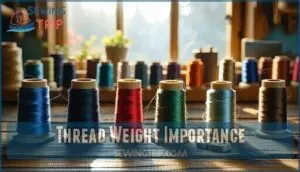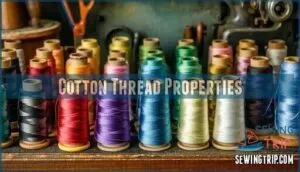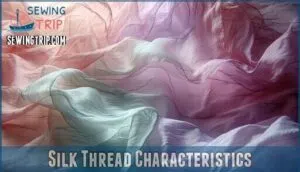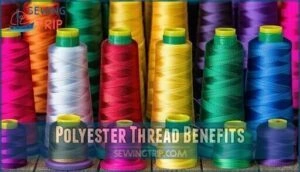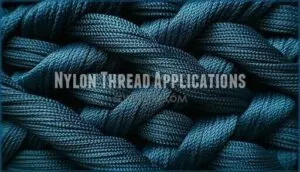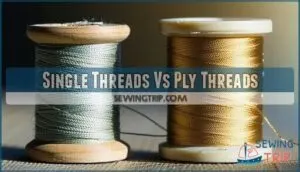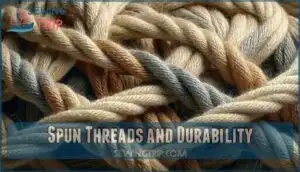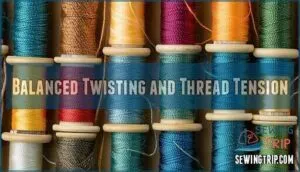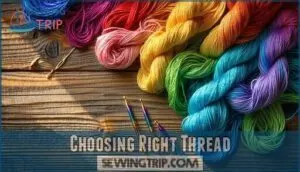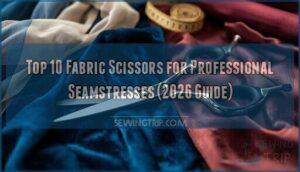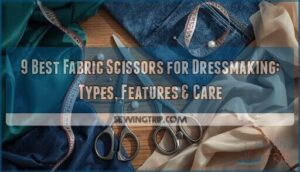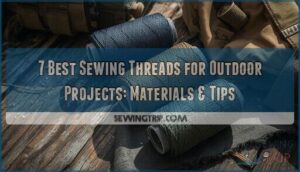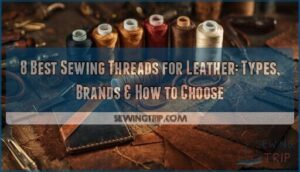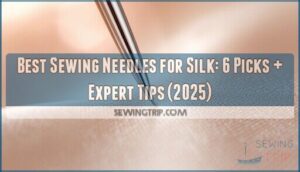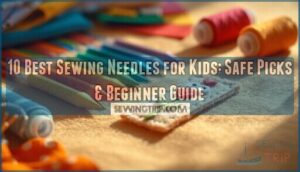This site is supported by our readers. We may earn a commission, at no cost to you, if you purchase through links.
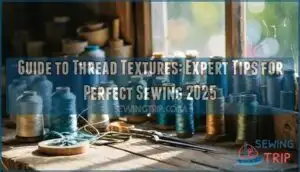 In sewing, selecting the right thread texture is essential. A guide to thread textures can help you explore the universe of threads.
In sewing, selecting the right thread texture is essential. A guide to thread textures can help you explore the universe of threads.
You’ll discover that threads are classified into natural and synthetic fibers, each with unique attributes. Natural fibers like cotton and linen offer a soft, breathable finish, while synthetic fibers like polyester and nylon provide unmatched strength and flexibility.
But that’s just the beginning. Thread weight, material selection, and construction effects all play a role in achieving perfect stitches. What’s the secret to selecting the right thread for your project?
Let’s explore the possibilities to find the right thread for your project.
Table Of Contents
- Key Takeaways
- Thread Texture Basics
- Thread Weight Importance
- Top 9 Thread Textures
- 1. 140 Colors Embroidery Thread Floss Kit
- 2. Navy Blue Embroidery Machine Thread
- 3. Sewing Thread Kit 36 Colors
- 4. White Serger Thread Cones 4 Pack
- 5. Simthread Prewound Bobbins Assorted Colors Thread
- 6. Juki DDL8700 Industrial Sewing Machine
- 7. Brother PE545 Wireless Embroidery Machine
- 8. Brother SE2000 Sewing Embroidery Machine Bundle
- 9. Brother SE630 Sewing Embroidery Machine
- Thread Material Selection
- Thread Construction Effects
- Choosing Right Thread
- Frequently Asked Questions (FAQs)
- Conclusion
Key Takeaways
- You need to match thread type and weight to your fabric and project—that’s how you get pro-looking results every time.
- Don’t overlook thread construction and fiber blend; they affect strength, sheen, and how your finished stitches will look and feel.
- Synthetic threads like polyester and nylon give you durable results and stretch, while naturals like cotton and silk let you control texture and eco-friendliness.
- Always check for compatibility with your machine, fabric thickness, and intended use so your thread won’t break or ruin your design.
Thread Texture Basics
Thread textures determine how your finished project looks and feels, making them essential for achieving professional results.
Thread textures are the secret to professional-looking results, transforming your projects from amateur to amazing.
You’ll discover that understanding fiber characteristics helps you match the perfect thread to your fabric and create the exact texture you want.
Natural Fiber Characteristics
Natural fibers bring unique characteristics to your sewing projects through their fiber surface morphology and inherent properties.
Cotton durability makes it perfect for everyday items, while silk sheen adds luxury to delicate work.
These natural fibers offer superior biodegradability compared to synthetic alternatives, supporting eco-conscious crafting.
While natural options excel in this area, synthetics offer greater wear and tear resistance.
- Cotton’s absorbent nature creates matte textures that feel soft against skin
- Wool’s crimped structure provides natural elasticity and warmth retention
- Silk’s smooth protein fibers deliver unmatched luster and drape quality
Synthetic Fiber Properties
Everyone knows synthetic fibers revolutionize modern sewing with their engineered properties.
Polyester durability stands out in high-wear applications, while nylon strength excels in heavy-duty projects.
Acrylic softness mimics wool’s comfort without the bulk, and Rayon sheen provides silk-like luster at affordable prices.
Synthetic blends combine multiple benefits, creating versatile options.
These synthetic fibers offer consistent thread properties including superior thread texture and reliable thread sheen for professional results.
Blended Fiber Benefits
Tap into the power of blended fibers to boost your sewing results.
Thread blends combine the best properties of each material, offering Enhanced Strength, Durability Enhancement, and Cost Efficiency.
You’ll notice improved fabric compatibility and a wide Texture Variety.
Blended fibers also deliver Unique Aesthetics, letting you fine-tune thread texture for any project while maximizing thread properties and performance.
Thread Weight Importance
Thread weight directly affects the look, strength, and performance of your stitches. Choosing the correct weight guarantees your thread matches the fabric and the demands of your project.
Measuring Thread Weight
When measuring thread weight, you’ll see numbers like 40wt or 50wt—lower numbers mean thicker threads.
Thread thickness guides help compare weight number meaning and denier vs weight systems. Denier measures mass per 9,000 meters, while weight uses length per gram.
Fine thread handling requires careful tension. For mending, choose thicker thread size for extra strength.
Always check thread measurement to ensure the right thread weight.
Thread Weight and Fabric Compatibility
Once you’ve figured out thread weight, focus on Weight vs. Fabric for your project.
Light thread thickness works best for delicate fabrics, while heavy threads suit tough materials like denim. Always match thread thickness to fabric thickness for proper fabric matching and project suitability.
For outdoor projects, consider using polyester thread options for enhanced durability.
Choose the right needle size to prevent snags and guarantee smooth thread selection and fabric compatibility every time.
Choosing The Right Thread Weight
A smart thread choice starts with matching thread weight to fabric thickness and project needs.
Thread Weight Measurement guides you—thicker threads suit heavy fabrics, while finer threads work best for delicate materials.
Thread Thickness Impact shows in design appearance and durability.
Always consider Fabric Compatibility and Project Type during thread selection to achieve the right balance for your sewing results, ensuring a good Thread Weight Measurement.
Top 9 Thread Textures
You’ll discover nine exceptional thread options that deliver superior texture and performance for your sewing projects.
These carefully selected threads represent the best combinations of durability, smoothness, and visual appeal available in today’s market.
1. 140 Colors Embroidery Thread Floss Kit
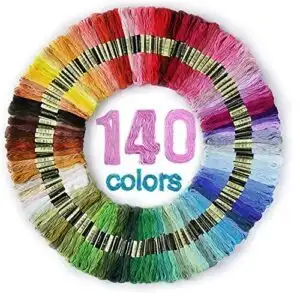
When you’re diving into embroidery projects, the LOVIMAG 140 Colors Embroidery Thread Floss Kit opens up a world of creative possibilities.
This cotton-based floss delivers smooth, non-fading threads that won’t leave you pulling your hair out with knots and snags.
Each 8.75-yard skein contains six divisible strands, letting you control texture from delicate details to bold, raised effects.
The rainbow color selection means you’ll rarely hit a wall searching for the perfect shade.
Machine washable and beginner-friendly, this kit transforms complex thread painting and friendship bracelet projects into manageable adventures.
Best For: Anyone from beginners to hobbyists seeking a wide variety of quality colors for embroidery, crafting, or friendship bracelet projects.
- Includes 140 vibrant, non-fading, and machine-washable colors in one set.
- Threads are smooth, strong, and easy to separate for versatile use.
- Highly rated for value, ease of use, and quality, especially for beginners.
- No color labels or codes, making color matching harder.
- Only one skein per color—no duplicates in the 140-pack.
- Occasional knots in strands may require attention.
2. Navy Blue Embroidery Machine Thread
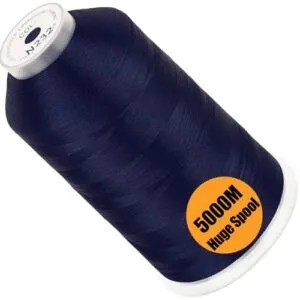
Navy blue embroidery machine thread delivers professional-quality results with its 100% polyester construction.
You’ll find over 1500 colors available, with navy blue being particularly popular for its versatility.
This 40-weight thread runs smoothly at 800 stitches per minute on most machines, though some colors may require slower speeds.
The 5000-meter spools offer excellent value, providing consistent coverage without breaking or tangling issues that plague cheaper alternatives, making it a great choice for professional-quality results.
Best For: Professional and home embroiderers seeking reliable, high-quality polyester thread in a versatile navy blue shade.
- Some colors may require reduced speed due to longer dyeing times.
- Large spool size may not fit all machines or be practical for casual users.
- Users need an upright thread stand for home-based machines.
- Wide color selection and large 5000M spool offers excellent value.
- Strong, smooth-running 40WT thread resists breaking and tangling.
- Suitable for a wide range of machines and embroidery techniques.
3. Sewing Thread Kit 36 Colors
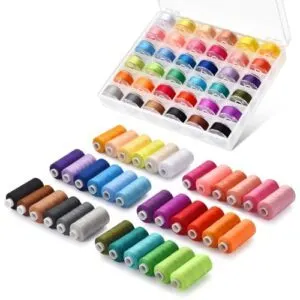
A rainbow of options, the Sewing Thread Kit 36 Colors lets you tackle nearly any sewing project with confidence. Each spool holds 400 yards of strong polyester thread, known for resisting fraying and breakage.
The kit includes matching prewound bobbins and a clear case, making organization easy. Threads glide smoothly through machines and work well for hand sewing too.
For intricate stitch patterns, consider durable polyester threads. The color variety means you’ll always have the right shade for quilting, repairs, or crafts.
Best For: Beginners, DIY crafters, and anyone needing a variety of thread colors for sewing, quilting, or repairs.
- Some spools lack accessible thread tails, requiring manual extraction
- Thread quality is adequate but not premium for professional-level projects
- No storage case provided for the thread spools themselves
- Vibrant color selection with matching prewound bobbins for easy organization
- Strong, smooth polyester thread that resists fraying and breakage
- Compatible with most sewing machines and suitable for hand sewing
4. White Serger Thread Cones 4 Pack
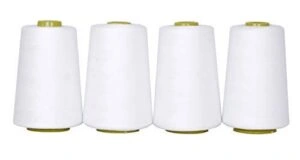
Anyone tackling big sewing projects knows the value of a reliable thread.
White serger thread cones, sold in packs of four, are a staple for both home and commercial sewists.
Made of 100% spun polyester, these threads offer strength, durability, and low lint.
Each cone holds 6,000 yards, so you’ll spend less time changing spools.
The consistent white color blends well with light fabrics, making it ideal for overlocking and seams.
This thread resists stretching, shrinking, and fraying, ensuring lasting, professional results.
Best For: Home sewers and commercial operations needing bulk, reliable white thread for sergers, overlock machines, and general sewing projects on light-colored fabrics.
- Mixed customer feedback regarding packaging quality and occasional shipping of incorrect or incomplete orders
- Thread thickness may be incompatible with some serger models, potentially requiring machine adjustments or tension modifications
- Limited purchasing flexibility with no single-cone options available for users wanting to test compatibility first
- High-capacity 6,000-yard cones reduce frequent thread changes during large projects, improving workflow efficiency
- Durable 100% spun polyester construction resists breaking at high speeds while maintaining consistent tension through serger mechanisms
- Cost-effective 4-pack bulk packaging offers significant savings compared to individual spools, ideal for heavy users
5. Simthread Prewound Bobbins Assorted Colors Thread
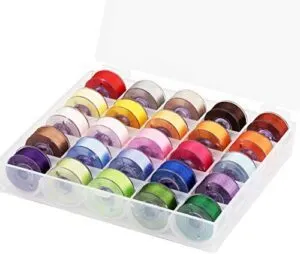
These pre-wound bobbins pack a punch for busy sewers who value efficiency over winding time.
You’ll get 25 bobbins loaded with 140 yards of smooth 60-weight polyester thread in randomly selected colors.
The Size A Class 15 design fits most Brother, Babylock, Janome, and Singer machines perfectly.
Each bobbin delivers consistent tension and minimal breakage during high-speed embroidery work.
The included storage box keeps everything organized between projects, ensuring efficient use of the bobbins.
Best For: Busy sewers and embroiderers who want a time-saving, ready-to-use bobbin solution for compatible machines.
- Thread colors are randomly selected, so you can’t pick your favorites.
- Some users find the thread too thin for certain projects.
- Bobbins may unwind during shipping and need rewinding.
- Saves time by eliminating manual bobbin winding.
- Compatible with most popular sewing and embroidery machines.
- Comes with a clear storage box for easy organization.
6. Juki DDL8700 Industrial Sewing Machine
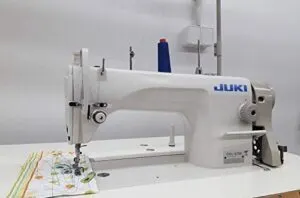
If you’re after speed and reliability, the Juki DDL8700 industrial sewing machine stands out.
Its high-speed lockstitch design handles lightweight to medium fabrics with ease, thanks to a servo motor that gives you control over stitch length and speed.
You’ll find the machine quiet, with low vibration, making long sewing sessions more comfortable.
The large arm space is great for quilts or big projects.
While setup can be tricky, especially with assembly, performance and stitch consistency make this machine a favorite for professionals.
Best For: Professionals and serious hobbyists who need a fast, reliable industrial sewing machine for frequent or large projects.
- Assembly can be confusing and may require extra parts or adjustments
- Table and accessory quality are inconsistent with some manufacturing defects
- Customer support and seller reliability reported as poor by buyers
- High-speed operation with quiet, low-vibration performance
- Large arm space accommodates quilts and big projects
- Consistent, high-quality stitches for lightweight to medium fabrics
7. Brother PE545 Wireless Embroidery Machine
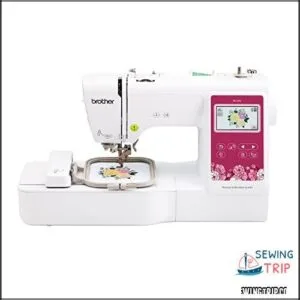
With the Brother PE545 Wireless Embroidery Machine, you get a compact tool that brings modern convenience to your sewing space.
Its 4" x 4" embroidery area is perfect for small projects, and the wireless LAN lets you transfer designs from your PC or mobile device.
The 3.7” color touchscreen makes editing and positioning easy.
It supports cotton, polyester, and rayon threads, so you can experiment with various textures, and built-in tutorials and accessories help beginners and experienced users achieve consistent, high-quality results.
Best For: Beginners and hobbyists looking for an easy-to-use, compact embroidery machine with wireless design transfer.
- Limited to a 4" x 4" embroidery area, restricting project size.
- Occasional thread tension and file compatibility issues reported.
- Not suitable for traditional sewing or larger commercial projects.
- Wireless LAN and app connectivity for easy design transfer from PC or mobile.
- User-friendly touchscreen with built-in tutorials for quick learning.
- Quiet operation and reliable performance for home use.
8. Brother SE2000 Sewing Embroidery Machine Bundle
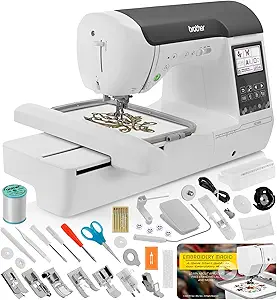
If you want a machine that balances innovation with reliability, the SE2000 bundle is worth a look.
You get 193 built-in embroidery designs, 241 sewing stitches, and a 5" x 7" embroidery field, making it versatile for quilting, monogramming, or crafts.
The automatic thread tension and jump stitch trimming keep your threadwork clean, and features like Wireless LAN and app compatibility let you transfer designs easily, which is a key factor for mastering both simple and intricate projects.
With strong customer support and durable construction, this bundle helps you work with confidence.
Best For: Beginners and experienced sewists who want an easy-to-use, feature-rich embroidery and sewing machine for a wide range of projects.
- Maximum embroidery area is limited to 5" x 7", which may be small for some advanced projects.
- Learning curve for mastering all features and software integration, especially for complete beginners.
- Higher price point compared to basic sewing or embroidery machines.
- Large selection of built-in designs and stitches, plus app and wireless connectivity for easy design transfer.
- Handles thick fabrics and multiple layers smoothly, with automatic thread tension and jump stitch trimming.
- User-friendly touchscreen and strong customer support make it approachable for all skill levels.
9. Brother SE630 Sewing Embroidery Machine
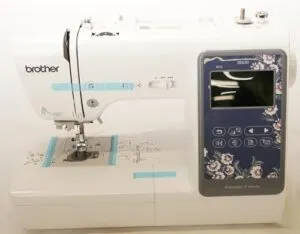
Through its 4×4-inch embroidery area, the Brother SE630 delivers exceptional thread texture control with 480 built-in designs and 103 sewing stitches.
You’ll master precise thread manipulation using the 3.7-inch color LCD touchscreen, which previews how different thread textures will appear in your final project.
The machine’s variable speed controls let you adjust stitching pace for delicate silk threads or robust cotton varieties.
With USB connectivity for custom designs and built-in memory, you can experiment with various thread combinations and save successful texture patterns for future projects.
Best For: Crafters and sewers seeking a versatile machine that combines sewing and embroidery capabilities with user-friendly computerized features and extensive built-in design options.
- Exceptional versatility with 480 built-in embroidery designs and 103 sewing stitches, plus USB connectivity for importing custom designs
- User-friendly 3.7-inch color LCD touchscreen with intuitive navigation and design preview capabilities
- Variable speed controls and precision features like needle up/down positioning for optimal thread texture control
- Software for converting designs to PES format not included, requiring additional costly purchases
- Some users report issues with needle threader reliability and occasional bent needles during heavy-duty projects
- Limited 4×4-inch embroidery area may restrict larger design projects
Thread Material Selection
When you select thread material, you control the strength, texture, and appearance of your sewing project.
Thread material selection is key to a project’s strength, texture, and appearance
Each type—cotton, silk, polyester, or nylon—offers unique properties that affect durability and finish.
Cotton Thread Properties
After exploring top thread textures, it’s time to get hands-on with cotton thread.
Cotton stands out for its natural fibers and impressive cotton durability.
Its easy dyeing process means a rainbow of choices for any project.
As a quilting thread, cotton delivers smooth stitches and reliable thread quality.
Cotton thread strength impacts project longevity.
Fiber blends with cotton add versatility, making it a favorite in any thread texture guide.
Silk Thread Characteristics
If you’ve enjoyed the strength of cotton, silk threads bring something special to your thread texture guide.
Silk sheen stands out, making any stitch glow. You’ll notice thread smoothness and fiber delicacy, perfect for luxury projects or silk embroidery.
Consider purchasing quality threads for best results. Evaluate thread luster and softness—silk threads are prized for their elegant finish, adding a refined touch to detailed work, with a notable silk sheen.
Polyester Thread Benefits
In the context of polyester thread, its durability and colorfastness make it a top choice for many sewing projects.
Polyester thread offers excellent stretch and recovery, making it ideal for synthetic materials and high-wear projects.
Its versatility and affordability also make it a popular choice for a wide range of applications.
Nylon Thread Applications
You’ll find nylon thread in industrial uses, outdoor gear, and automotive applications, leveraging its strength and durability.
It’s ideal for safety equipment and luggage manufacturing, offering high thread strength among synthetic fibers, making it a popular choice for various applications requiring durability and resistance.
However, due to its lack of UV resistance, it’s important to keep in mind polyester thread alternatives for outdoor projects.
Thread Construction Effects
You’re about to learn how thread construction affects your sewing projects.
Thread construction effects, such as single threads vs ply threads, impact the strength and performance of your threads, so understanding these differences is vital to choose the right thread for your needs.
Single Threads Vs Ply Threads
You’ll discover thread strength and smoothness factor differ between single threads and ply threads.
Ply threads prevent kinking and guarantee consistent tension, impacting performance and thread textures.
Thread construction affects single threads and ply threads, influencing overall thread types and their uses.
Spun Threads and Durability
Typically, spun threads deliver superior durability through fiber blending during the spinning process.
This construction method creates enhanced strength and abrasion resistance that outlasts single filament alternatives.
- Fiber Blending: Multiple fiber types combine during spinning for maximum thread uniformity
- Enhanced Strength: Twisted fibers create stronger bonds than individual strands
- Abrasion Resistance: Spun construction withstands friction better than smooth filaments
- Thread Durability: Consistent performance across various fabric texture analysis applications
Balanced Twisting and Thread Tension
Thread tension creates the foundation for smooth stitching.
Balanced twisting prevents kinking while maintaining thread smoothness and consistent performance.
You’ll achieve tension consistency by using identical thread types for top and bottom stitching.
Test twist direction through the ‘U’ method – proper balanced performance keeps thread portions parallel.
Adjust settings gradually to prevent embroidery thread issues and maintain ideal thread properties throughout your project.
Thread tension is crucial for smooth stitching and overall project quality.
Using the ‘U’ method to test twist direction ensures proper balanced performance.
Choosing Right Thread
Selecting the right thread transforms your sewing projects from amateur attempts into professional masterpieces.
You’ll need to take into account fiber content, weight, sheen, and durability to match your thread perfectly with your fabric and project goals, which is crucial for achieving professional results.
Factors Affecting Thread Choice
Several key factors shape your thread selection decisions and directly impact your sewing success.
Thread strength determines how well your seams withstand stress and wear. Stitch density affects how much thread you’ll need and influences the final texture.
Thread elasticity helps fabrics move naturally without breaking seams. Chemical resistance protects against detergents and environmental damage.
Abrasion resistance guarantees longevity during use. Consider your project needs, fabric thickness, and appropriate thread weight when making material selection choices.
Thread strength is crucial for withstanding stress and wear.
Fiber Content and Material Properties
Different fiber content directly affects your thread’s texture and performance.
Cotton Properties include natural durability with easy dyeing capabilities.
Silk Characteristics offer premium strength with beautiful sheen for luxury projects.
Polyester Benefits deliver excellent stretch and color retention.
Nylon Applications excel in heavy-duty work requiring maximum tensile strength.
Rayon Performance blends natural feel with synthetic durability, making material properties your key consideration when selecting embroidery thread types.
Sheen and Luster Considerations
Material sheen levels dramatically transform your project’s final appearance.
High-sheen threads like silk and rayon create luminous, eye-catching effects through superior light reflectivity.
Cotton provides matte finishes with minimal surface smoothness.
Thread finish options include glazed treatments that enhance textile surface properties.
Consider how thread luster complements your fabric’s visual texture impact when selecting thread sheen for ideal thread appearance results.
Colorfastness and Durability Factors
When selecting the right thread, you want to verify it can withstand the test of time and various environmental factors.
Key factors to consider, as they directly impact the thread’s ability to resist fading, abrasion, and chemical damage, are colorfastness and durability.
Project Type and Fabric Compatibility Considerations
When choosing thread, consider your project’s complexity and fabric weight.
Adjust stitch density and thread tension accordingly. Machine settings also impact thread selection.
Confirm fabric compatibility by selecting suitable thread types, meeting your project needs. Selecting thread from well-known brands can help guarantee consistent results with the right thread selection.
Frequently Asked Questions (FAQs)
How does thread texture affect a design?
You’ll find that thread texture substantially impacts design, as it alters appearance, durability, and overall aesthetic, allowing you to create unique effects and dimensions in your projects with varying threads.
How do I choose the right thread for my design?
You select threads based on fabric type, project needs, and desired texture, considering factors like durability, colorfastness, and sheen to achieve your design goals.
What is a good thread guide?
You’ll want a thorough thread guide that covers types, materials, and applications to help you make informed decisions for your projects.
What thread should I use for embroidery?
You’ll likely use cotton or rayon thread for embroidery, as they’re popular for their versatility, durability, and shiny appearance, making them ideal for various embroidery projects and techniques.
What is textured filament thread?
You’ll use textured filament thread, which is highly elastic and soft, commonly used in overlock machines for rolled hems, providing a smooth finish to your sewing projects easily.
How do I choose the right thread for my fabric match?
Like matching dance partners, your thread should complement your fabric’s weight and fiber content.
Choose cotton for natural fabrics, polyester for synthetics, and silk for delicate materials.
Match thread weight to fabric thickness for ideal results, ensuring your thread complements the fabric’s properties, such as fabric thickness.
What threads work best for outdoor projects?
Choose polyester or nylon threads for outdoor projects. They resist UV rays, moisture, and temperature changes better than natural fibers. Polyester offers excellent durability and colorfastness for long-lasting results.
Can I use silk thread for quilting?
You can quilt with silk thread, but it’s not ideal due to its smooth, slippery nature and potential for breakage under tension or stress.
How to prevent thread breakage easily?
Keep thread breakage at bay by using the right needle size, checking thread quality, and maintaining even tension.
Double-check threading, reduce sewing speed if needed, and keep your machine free of lint for smooth stitching every time, ensuring even tension.
Are recycled threads suitable for clothing?
When life gives you lemons, stitch sustainably—recycled threads work well for clothing.
They’re durable, colorfast, and eco-friendly.
You won’t sacrifice quality for greenness, but check the label for fiber blends to match your fabric’s needs, using recycled threads.
Conclusion
Much like the final stitch that pulls your masterpiece together, using a guide to thread textures guarantees your sewing project stands strong.
You’ve learned how different threads, from cotton to nylon, deliver distinct results.
By weighing fiber qualities, thread weight, and construction, you’ll elevate every piece you create, and choose thread with purpose.
Don’t settle for less—now, you’re ready to tackle any sewing challenge with confidence, knowing your guide to thread textures has you covered for perfect stitches.
- https://khgarts.com/blog/all-about-that-thread-part-ii/
- https://www.sewingpartsonline.com/blogs/education/ultimate-thread-reference-guide-2
- https://lindehobby.com/the-differences-in-sewing-thread-1660/
- https://egausa.org/app/uploads/2023/01/EGA-Embroidery-Needlework-Glossary-2023.pdf
- https://www.youtube.com/watch?v=DB1B_rePyPU&pp=0gcJCdgAo7VqN5tD

